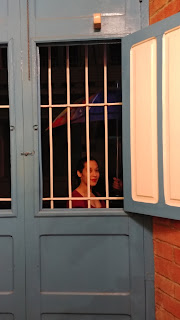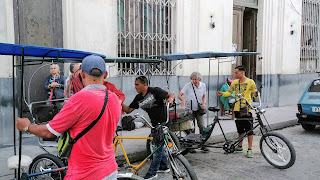Jan. 29, 2018-Havana
Jose's description of
the Cuban government: Every move you make, every breath you take. I'll be
watching you.
It was such a Cuban
touch. When we had our Shakespearean moment on our way to Havana, I had a
cappuccino. It came with two pieces of sugar cane to use as stirrers. I may
need to see the dentist for a special cleaning when we get home.
We watched a video about
Hemingway on the bus after our rest stop on the 4-hour drive West to Havana.
Ernest Hemingway spent half his life in Cuba. The island inspired many of his
works. He was 29 years old the first time he visited. He returned for the great
fishing. He rented a boat from a rum running bootlegger with whom he became
lifelong friends. His second wife had a hard time giving birth. She was advised
not to have more children. As a Catholic, she chose abstinence. Hemingway began
having affairs & met a new love. She was married to a man Hemingway
considered too weak to hold on to her. When her husband found out, she tried to
sneak into Hemingway's hotel room by climbing along a ledge. Some people say it
was suicide, but she fell and died.
Hemingway fancied
himself a naturalist. He wanted to preserve animals to hunt them. He maintained
that you can't get closer than at the time of killing. In 1939, he met his
third wife. She didn't want children so he befriended local kids &
organized a baseball team.
For a time, he tried to
track and destroy a Nazi U-boat. Then wanted to capture one seen off the coast.
When he finally saw the sub he couldn't catch it. He met his 4th wife & had
the wedding reception at his favorite bar, La Floridita. It was his final and
longest marriage. Even then, he met a 19 year old woman whom he invited to
Cuba. Some said he needed to be in love in order to write.
He was starting to
suffer physical problems including impotence. In 1954, he won the Nobel Prize
after writing Old Man and the Sea. After two airplane crashes and other
ills, he went to the US for treatment. He felt betrayed by his body and knew
he'd never return to Cuba. Suicide in 1960, was his solution.
After his death, his
connection with Santeria was researched. It's a combination of African animism
and Catholicism. He may have participated in it.
More on Che, the person.
He was a physician who grew up in a wealthy Argentinian family. He had asthma
since he was four. He used a primitive inhaler and had difficulty when with
troops in the mountains. His first marriage produced a daughter. His second
marriage yielded four children. All five of his progeny are educated and
productive citizens of Cuba. Che's grit is best illustrated by the statue atop
his memorial. He has a rifle in his right hand and a cast and sling on his left
arm. It portrays the time he fought on while injured.
Jose elaborated on
Cuba's connection with the outside world. They have complete and easy IT access
for a pittance. The government knows of it and doesn't interfere, but it's a
private enterprise. El Pacquete are internet cards that allow Cubans to
download anything on line: movies, newspaper, tv shows, etc. They call the
person selling the card and it is delivered to their home. Hot spots are
available in many public parks. Jose says Cubans are the new Pirates of the
Caribbean. Where there's a will.....
The approach to Havana
was along the water and promenade. Soviet apartments painted in bright colors
were everywhere. The paint didn't help the uglies. There's no gambling in Cuba
anymore except for secret cock fights. Myer Lansky took a contract of a million
dollars out on Fidel after his casinos were closed. Obviously, it didn't work.
Jose & Manuel tried
out a new paladare for lunch, Decameron. It was a step up from what we've had.
I think they'll keep it in their repertoire. We had complimentary daiquiris and
I added to the 3 coffees I'd already imbibed. When we left, my body didn't know
if it wanted to pass out or run a marathon.
With that, we hit the
streets in Old Havana. We covered Cathedral Square, Plaza de Armes, &
walked the promenade across from the iconic El Moro Castle. Havana was well
fortified in the day and was never overrun. No revolutionary battles were
fought here. I hope Trump doesn't know of the success of this defensive wall.
We found Hemingway's favorite bar for mojitos. He had another one for
daiquiris. My takeaway from the walk was the smell of fish, cigars, and auto
exhaust.
Our last destination was
the cemetery, established in 1871, where Columbus isn't buried. His body was
returned to Spain. Still it's called Columbus Cemetery. We had a special guide
for this visit. He told us the cemetery covered 138 acres. Original plots had
to be paid for in gold. It's a conglomeration of ostentatious mausoleums and
tombs. Graves can be 10 feet deep or more. Some go down several stories inside
the mausoleums & have elevators. Fidel put an end to the elaborate display
and today's graves are more modest. There are 40 funerals/day. There were three
hearses that pulled in during our short visit.
Originally a Catholic
cemetery, now others are permitted burial. The guide pointed out the tomb of a
Jewish man, Steinhart, who was the first US consul to Cuba. He became a wealthy
man starting businesses and investing in the country. With the help of the
guide who knew the tradition, David & I found rocks to place on his tomb
& we said a "misheberach." Steinhart's family lives in NYC but
there were many rocks from other visiting Jews.
We passed the sky-scraper
that is the US Embassy on our way to check in to the hotel. It sits on the
waterfront and has about 20 concrete barriers with iron poles imbedded at the
front entrance. It is all but abandoned. We didn't hear any strange noises as
we cruised along.
We're staying our last
three nights in Cuba at Hotel Nacional built in 1930. It's significant to us
since our parents stayed there in the 40's. It's a sad old lady now. The
grandeur is in the grounds, exterior, and main rooms. Our room is a fire trap
with exposed wires wrapped in tape and a lamp plug that is frayed. The toilet
has what I call a pump flush. It takes about six quick consecutive flushes
before the bowl clears. The A/C works, but we can't control the temperature.
The phone repeatedly rang, but no one was at the other end. Every time we
answered, the phone fell apart. We're on the waterfront side, but the windows
are so dirty it's hard to see out. But it has the best FREE wifi that works in our room, and we have separate
codes for the phone and iPad. Living large!
Dinner was an elaborate
buffet in the hotel. We had pasta bar which was pretty good after weeks of rice
and chicken. We sat with the folks from Minnesota. It was quite fortuitous. We
talked about Wendy and Julian moving to acreage in Hinckley. The couple knew the
town well. Then they told us his niece was a lesbian. She and her partner live
in the Twin Cities. His sister-in-law was having trouble accepting it. We
talked about PFLAG. Who'd a thunk.
Tomorrow we go back to
the old city to plaza hop.
Toby
 |
| Iconic Cars |
 |
| Cathedral Square |
 |
| Hemingway's Favorite Mojito Bar |
 |
| Steinhart Tomb |

































